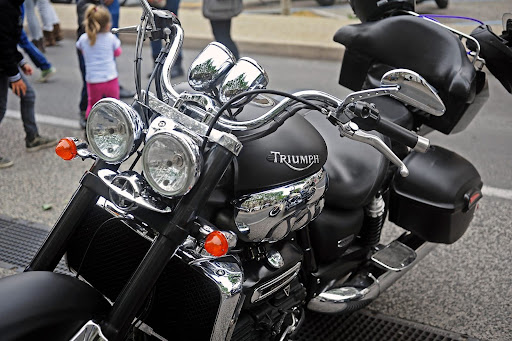There’s something magical about the rumble of a vintage Triumph beneath you as you cruise down a winding coastal road, the salt air filling your lungs and the heritage of British engineering between your legs. For years, my 1972 Triumph Bonneville was my pride and joy, my weekend warrior, and my therapy session all rolled into one glorious machine.
But six months ago, I did something that shocked my riding mates – I traded in my beloved classic for a modern beast: a Ducati Panigale V4. The transition from vintage British iron to Italian racing technology has been nothing short of a wild ride, and today I’m sharing my honest thoughts on making the leap from classic to cutting-edge.
The Romance of the Vintage Ride
My Bonnie wasn’t just a bike; it was a relationship. Like any good Aussie romance, it was complicated. I knew her quirks intimately – the way she needed gentle coaxing on cold Tassie mornings, how her carbs would occasionally flood if I was too eager with the throttle, and the particular sequence of mechanical incantations required to bring her back to life when she decided to have a sulk.
What I miss most about the Triumph is the visceral connection to the road. You don’t just ride a vintage bike; you negotiate with it constantly. Every bump, every lean, every acceleration is a conversation between rider and machine. The mechanical simplicity meant I could fix most issues with basic tools and a bit of bush mechanic ingenuity – something that’s saved my bacon more than once in the Outback.
The Technological Marvel
Switching to the Ducati Panigale was like trading in a trusty bush knife for a lightsaber. This Italian masterpiece doesn’t just perform; it computes, calculates, and collaborates with you. The first time I opened the throttle fully on a straight stretch of the Putty Road, I nearly left my stomach behind. The acceleration is nothing short of violent, in the most exhilarating way possible.
The technology packed into modern superbikes is mind-boggling. Traction control, wheelie control, engine braking control, multiple riding modes, and a quickshifter that makes gear changes feel telepathic. On my old Triumph, ABS meant “Always Be Smooth” with the brakes – now it’s a sophisticated electronic system keeping me rubber-side down.
The Riding Experience
The most profound difference? Ergonomics. My Bonnie let me sit upright, taking in the scenery and waving to fellow riders. The Panigale, however, demands commitment. It puts you in an aggressive forward posture that screams “track day” rather than “Sunday cruise.” After a two-hour blast through the Adelaide Hills, my wrists and lower back remind me I’m not 25 anymore.
But then there’s the precision. Cornering on the Ducati feels supernatural – like the bike is reading your mind rather than responding to inputs. Where the Triumph required muscling through corners with deliberate countersteering, the Panigale dances through turns with ballerina-like grace and Formula 1 levels of grip.
Maintenance Tales
If you’ve ever owned an Italian vehicle of any kind, you know what’s coming. The Ducati’s service schedule is as demanding as a helicopter parent. The Desmodromic valve system requires specialist knowledge, and the service intervals come with eye-watering price tags that make me occasionally question my life choices.
My Triumph, bless her heart, was happier with regular tinkering – oil changes in the garage, valve adjustments while sharing a beer with mates, and carb cleanings that doubled as meditation sessions. The Ducati’s computer systems and precision engineering mean I’m now on first-name terms with my dealer’s service department. “G’day Marco, yes, it’s me again…”
The Social Aspect
Perhaps the most unexpected difference has been the social shift. On the Bonneville, I was part of a brotherhood of classic bike enthusiasts – blokes who appreciate mechanical simplicity and aren’t afraid to get their hands dirty. Our conversations revolved around restoration tips, parts sources, and tales from the good old days.
The Ducati crowd is different – there’s more talk of lap times, electronic settings, and the latest aftermarket exhausts that might shave off a few grams. Both communities are passionate, but they speak different languages.
At bike meetups, my Triumph drew nostalgic sighs from older riders and curious questions from youngsters. The Ducati draws whispered admiration and occasional eye-rolls about “midlife crisis machines.” I can’t say they’re entirely wrong!
The Verdict
So which is better? That’s like asking whether a perfectly grilled steak is better than a gourmet seafood platter. They’re both brilliant, just brilliantly different.
The Triumph was a companion that demanded respect, patience, and mechanical sympathy. Riding it was a dialogue with history, a connection to generations of riders who understood that the journey matters more than the destination.
The Ducati is a technological tour de force that constantly pushes the boundaries of what’s possible on two wheels. It’s not just transportation; it’s time travel, compressing distances in ways that seem to defy physics.
For now, I’m embracing the modern marvel that is my Italian stallion. But there are still days, especially when I see a perfectly maintained Bonneville rumbling past, that I feel a pang of nostalgia for simpler times and simpler rides.
And who knows? There might just be room in my shed for both philosophies someday.
Have you made a dramatic switch between bike styles? Share your experiences in the comments below. And until next time, keep the shiny side up!
Written by Michael Bankier

